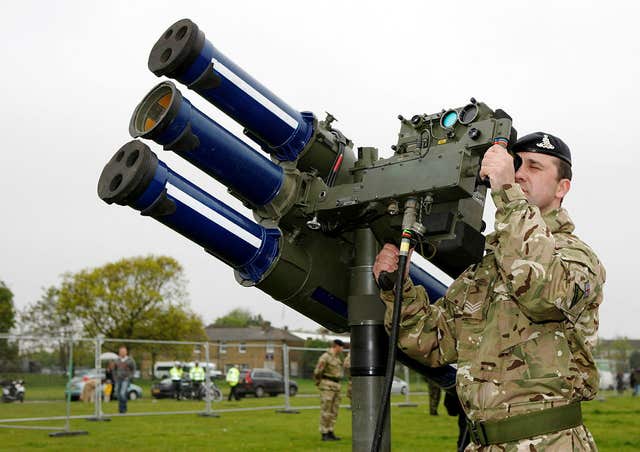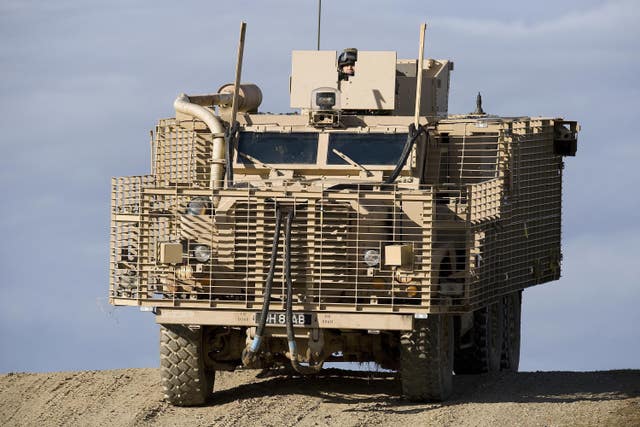Which weapons are the UK and other countries sending to Ukraine?
Boris Johnson has set out a fresh £300 million package of support for Kyiv’s military, including electronic warfare equipment.

Since Russia began its invasion of Ukraine in February, the UK and Western allies have been providing military aid to help Ukrainian forces resist Moscow’s advances.
After starting cautiously with helmets and flak jackets and then limiting supplies to defensive weapons, Western countries have massively stepped up their response.
Some 40 nations are now joining in delivering missiles, tanks and heavy artillery to help Ukraine’s efforts in countering Russia’s intensified offensive in the eastern Donbas region.
Prime Minister Boris Johnson on Tuesday set out a new £300 million package of support for Kyiv’s military as he saluted the resistance of Ukrainians in the face of the Russian invasion during an address to the country’s parliament.
Here is a look at what military aid the UK and other nations are sending.
– What lethal aid has the UK sent so far?
Britain began supplying arms to Ukraine in January, before Russian President Vladimir Putin launched his incursion, sending shoulder-mounted next generation light anti-tank weapons (Nlaws) which have been credited with helping to stall Moscow’s armoured units.
The UK has since intensified the effort and is one of the largest arms suppliers in Europe to Kyiv, having now delivered more than 5,000 Nlaws and other anti-tank missiles, 1,360 anti-structure munitions, five air-defence systems with more than 100 missiles, and 4.5 tonnes of plastic explosives, according to the Ministry of Defence.
Ukrainian ground troops have also been using Starstreak surface-to-air missiles supplied by the UK to defend themselves against aerial assaults for several weeks, Defence Secretary Ben Wallace told MPs last week.
– What other military support has the UK provided to Ukraine?
Mr Wallace said the UK has already given some £200 million in military aid to Kyiv.
The UK has also sent non-lethal equipment to Ukraine, including more than 90,000 ration packs, over 10 pallets of medical equipment, more than 3,000 pieces of body armour, nearly 77,000 helmets and 3,000 pairs of boots, as well as communications equipment and ear defenders.
Britain is training Ukrainian troops in Poland, as well as teaching a small number of Ukrainian soldiers on home soil how to use armoured vehicles.
The UK, alongside Polish, US and international partners, has also set up an international donor coordination centre in Stuttgart to coordinate the delivery of military assistance.

– What further military aid is the UK sending?
The Prime Minister on Tuesday confirmed a package of support worth £300 million for Kyiv, including a counter battery radar system to pinpoint artillery bombarding Ukrainian cities, GPS jamming equipment, heavy lift drones to supply its forces and thousands of night vision devices.
He said that “in the coming weeks”, the UK will send longer-range Brimstone anti-ship missiles to help Ukraine counter Russian warships in the Black Sea, as well as a small number of Stormer armoured vehicles, which carry Starstreak anti-aircraft missiles and are designed to provide a roving threat to Russian planes and helicopters.
The Government also announced that 13 armoured vehicles will start arriving in the country’s east in the coming days to evacuate civilians from besieged areas and protect officials rebuilding critical infrastructure amid ongoing Russian bombardment.
A £100 million package of high-grade military equipment announced by Mr Johnson earlier this month includes another 5,000 anti-tank missiles and high-tech precision munitions that loiter over the battlefield until directed to their target.
The Prime Minister also promised 120 armoured vehicles, including Mastiff six-wheel-drive patrol vehicles, and new anti-ship missile systems.
He also offered to send Challenger 2 tanks to neighbouring Poland so that Warsaw can donate its own to Ukraine.

– What defence assistance have other countries provided?
The United States has been Ukraine’s top contributor, providing more than three billion US dollars (£2.4 billion) of military aid since Russia invaded.
That includes the latest military package of 800 million US dollars (£638 million) announced by President Joe Biden last week, which consists of 72 howitzers and tactical vehicles to tow the artillery guns, 144,000 artillery rounds and 121 recently-developed Phoenix Ghost tactical drones.
More than half of the US howitzers are already in Ukraine, according to the Pentagon.
The White House has also supplied or promised Mi-17 helicopters, 1,400 Stinger anti-aircraft systems, more than 5,000 Javelin missile launchers capable of piercing the most sophisticated armour, thousands of rifles with ammunition and a range of other equipment.
The US and Turkey have both given Ukraine drones armed with missiles, while Canada has sent howitzers and ammunition and has promised eight armoured vehicles.
Germany, which has rewritten its longstanding defence policy that ruled out exporting weapons into war zones, last week announced its first delivery of heavy weaponry to Ukraine.
After weeks of mounting pressure at home and abroad, Berlin promised to send Gepard anti-aircraft tanks to Ukraine.
Newly-re-elected French President Emmanuel Macron has given a green light for the delivery of lorry-mounted Caesar cannons and Milan anti-tank missiles, in addition to around 100 million euro (£84 million) worth of military equipment already donated by Paris.
The European Union has signed off on a 500 million euro (£419 million) package to fund weapons for Ukraine, marking the first time in the bloc’s history it is helping provide arms for a warzone.
The Czech Republic has sent T-72 tanks, fighting vehicles and artillery systems and Slovakia has provided its S-300 anti-aircraft defence system.
Poland has sent equipment including drones and Javelin anti-tank missiles and has also pledged T-72 tanks.
Norway has shipped Mistral anti-air missiles and anti-tank weapons to Ukraine.
Belgium, Estonia, Greece, Finland, Latvia, Lithuania, the Netherlands, Portugal, Spain and Slovenia are also among the countries sending military equipment.
Outside of Europe, Australia has committed six howitzers, ammunition and refitted Bushmaster vehicles, while Japan shed its post-Second World War constraints on military exports to deliver bulletproof vests and helmets to the war-torn nation.





